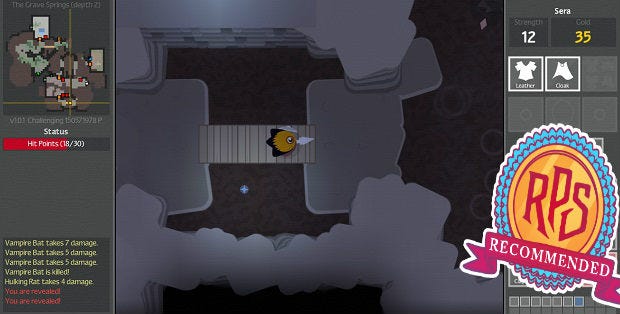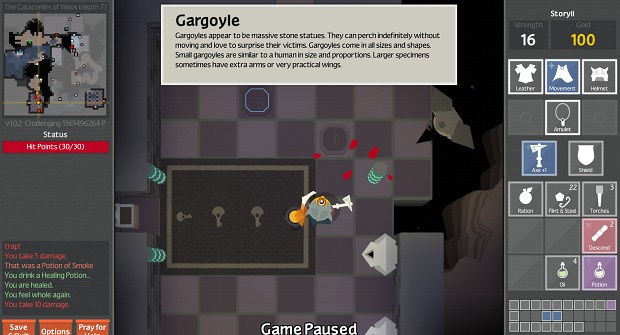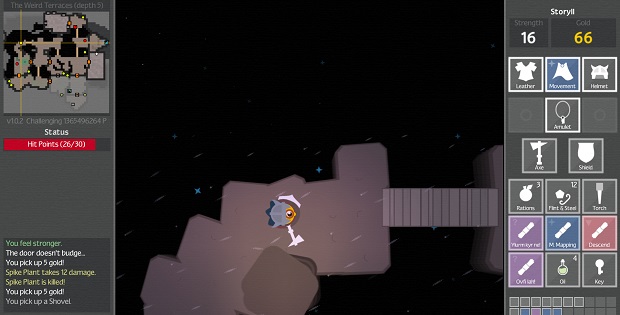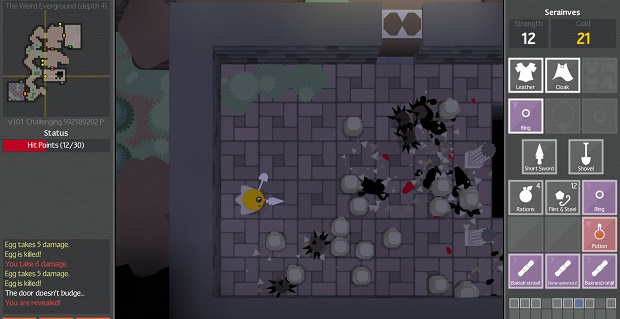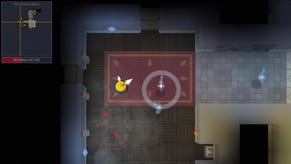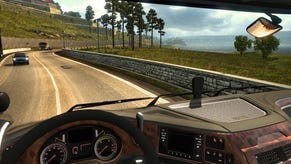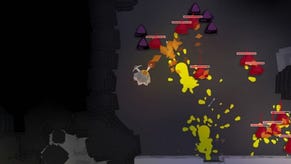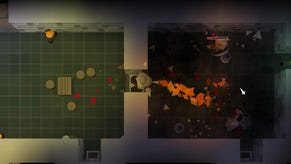Wot I Think: Unexplored
The best procedural dungeons
Unexplored [Steam page] generates some of the best dungeons I've ever seen. On my best run so far, I forged a sword of despair and enemies trembled and fled when I pointed it in their general direction. On my most entertaining run, a Dagger of Shrieking fused itself to my hand. Every twenty seconds or so, it would scream, alerting every bastard thing in the dungeon to my presence.
So many roguelikes (and lites), so little time. What a pleasure it is, then, to find Unexplored, a new dungeon-crawler that immediately stands out from the pack, and that can be played swiftly and without too much time spent on the learning curve. It's a wonderful game that creates my favourite procedural levels since Invisible, Inc.
Unexplored might end up being one of my favourite games of 2017. I'm going to say that up front so that it can be in the back of your mind as I talk through my initial reservations, all of which subsided very quickly. It's important to note them though because I think a lot of people will have similar doubts and I'm here to tell you that it's OK. It's worth getting to grips with the idiosyncracies, which range from a few awkward interface issues right up to the fact that it plays out in real-time, because the game that contains them is such a pleasure to play.
Let's get these out of the way then. The interface is mostly great: you don't need to learn lots of keyboard controls because most things are right click to examine, left click to use. The downside is that the screen is a bit cluttered, with the inventory taking up a big chunk of the right hand side, and yet still needing to be expanded if you want to dig deep into your pockets. It only took me fifteen minutes to accept that I'd be doing some sorting every now and again, shifting usable items to the visible top layer and dumping spare equipment into the hidden depths, but inventory management seemed troublesome because of the other big stumbling block...
Unexplored is a real-time roguelike. Oh no, I thought when I first started playing, everything is moving at the same time and now I am dizzy and frightened. It's fine though. More than fine, in fact; it's great.
The combat system is a bit like a realtime version of Deadly Rooms of Death. Your weapon sticks out in front of your character and you can walk into enemies to stab them. Many are rightly wary of your blade and will try to circle around you or retreat, knowing that once you strike the weapon is grayed out briefly, harmless during its cool-down. As well as poking at creatures, you can click a mouse button to use whatever is in your hands – left button for one hand, right for the other – which allows you to thrust, throw or swing, depending on your weapon of choice. These attacks are stronger but can leave you more exposed.
It's a system that allows for slow-paced combat, as much about positioning as stats, that can also escalate into panicked thrashing and fleeing when swarms of spiders or a single giant boss enemy attack. Shields can be raised to block, or weapons can be dual-wielded. Magical staffs provide ranged support in the off-hand and torches can be used to light your way as well as to ignite enemies, pools of oil or clouds of gas.
I found one other aspect of the game off-putting at first, and that's the character design. For reasons I couldn't fathom, all player characters are one-eyed folks and I didn't particularly like the look of them. Like everything else that made me frown, I soon understood the reason behind this decision though, and it's simple and quite elegant. A one-eyed character, viewed from above with the eye front and centre of the head, is extremely easy to read, in terms of their position and the direction they're facing. That, combined with the pointiness of equipped weaponry, makes controlling with a combination of keyboard for movement and mouse for targeting simple and efficient. No matter how cluttered the screen might be, the essentials are easy to read.
All of those initial reservations weren't just batted aside; I love the parts of Unexplored I was unsure about when I first started playing. And the rest, the actual RPG design that's at the heart of it all, is tremendous.
I'm so accustomed to dungeons that look like they could have been mapped out on graph paper, corridors and big blocky rooms strung together with no sense of being places that were constructed by anyone for any purpose, that Unexplored is a revelation. Every level I've seen has its own identity, with outdoor areas, void-straddling bridges and floating islands, underground lakes and lava spills, and temples, storehouses and barracks. The developers have made a very short video talking about the science of their approach.
Read more about how it works right here, and look at the maps in the top left of my screenshots. No grids and no obvious copy-and-paste rooms.
What all of that means, in practice, is that each level is structurally interesting, without too much backtracking, and can happily accommodate smart little puzzles. I've encountered levels with one big boss and rooms full of minions, and others were there's barely a fight to be had, but lots of libraries to loot. Others are packed with traps, or weird little signs that may or may not be cryptic clues. And those cryptic clues might lead to crypts, full of undead warriors waiting to wake.
Often you'll need to find a clue to figure out how to open secret doors or chests, and clues and keys might be a level above or below the target location, so backtracking is sometimes involved. Levels are small though, so it's never too much of a drag heading back up a couple of floors, especially if your findings have tipped you off about a big reward in the form of some neat magical weapon.
And you'll want that magical weapon because equipment is the only real way to improve your character. There's no levelling and every hero begins as a classless ball of potential. The one important stat is strength (these dungeons are no place for a Charisma 18 arts graduate like me), determining which weapons and armour you can use without detriment. But strength doesn't increase as you kill monsters, you have to find potions or equipment that buff your buffness.
It works beautifully, forcing you to explore and to try and solve puzzles and sneak by or kill enemies so you can find every last item on every level. Because there are no experience points, there's no incentive to kill everything; instead, you can use the stealth system to sneak by, or just outsmart them and trap them in their own dungeon by hitting levers to trigger traps or locking doors. By removing the linear path toward Mighty Hero Status, Unexplored's character-building is similar to its procedural dungeon generation: there are many routes and unexpected detours, and success comes from a combination of improvising with whatever is at hand, and choosing from the paths available.
Long-term, there are options to unlock for new starts, allowing you to experiment with a form of classes, and to buy more equipment at the beginning of a run. It's in the brief, individual adventures that Unexplored excels though. The novel approach to dungeon layouts and character-building makes all of the spider-smashing and key-hunting feel fresh. I play so many games of this type that the line between one and the next is often blurred. That makes it almost impossible for new games to find a spot on my regular roguelike playlist, but Unexplored has claimed one.
A single criticism remains, and that is a desire for more variety, in the form of enemy types and themed floors. It's not that the game is repetitive but I'm already expecting to spend months caught up in its traps and I want the surprises to keep on coming.
I'll finish how I started: Unexplored is almost certainly going to be one of my favourite games of the year.
Unexplored is out now, for Windows, and is available via Steam for £6.29.
